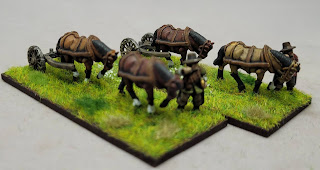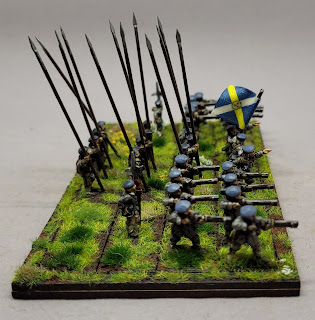London Trained Bands - Red Regiment
Trained Bands were a militia of part time soldiers; they were formally founded in 1571 under Elizabeth I, although their history dates back much further. Each County had a trained band, but in London there were a number of regiments. Initially there were north, south, east and west regiments; by 1638 four had become six regiments (now called red, white, blue, green, yellow and orange regiments), by the time of the First Civil War there were these six regiments and three suburban regiments (Southwark, Tower Hamlets and Westminster). Each regiment drew it's men from a particular district of the city. In 1643 they were expanded again by the formation of the auxiliaries, giving a total of eighteen regiments.
We know quite a lot about the London Trained Bands (henceforth LTB) thanks to the Royalist spy William Levett
The Red Regiment mustered it's men from Aldgate, Tower and Billingsgate. The Red Regiment was the senior regiment of the LTB. 'Red Regiment' refers to their flag colour, not their coat colours.
There is much confusion about what coat colours the LTB wore: Brigadier Peter Young wrote that the regiments wore the colour of coat matching their flag/name. This probably stems from contemporaneous confusion surrounding Sergeant Major General Randall Mainwairing. Mainwairing had a connection to the red auxiliaries, but also raised another Regiment of Foot from London (not part of the LTB) who wore red coats lined with white. Witnesses mention red coats and LTB regiments marching out together.
There are extensive records of equipment issued/loaned to the LTB none of which make reference to coats or buff coats; which, considering the minutiae in the records, would be a glaring omission. So we can only assume soldiers of the regiments provided their own clothing.
Pikeman often wore 'trained bande buffe'*, a sleeveless buff coat. Membership of a Trained Band was often associated with being a member of a guild, and guild members were expected to have the wherewithal to equip themselves.
The LTB regiments have a reputation for packing up and going home during long campaigns. As business men they had to return to their businesses and trades to keep the money coming in. It was this state of affairs that led to the formation of the LTB auxiliary regiments - who were full time professional soldiers.
The Red Regiment were believed to be at Turnham Green; fought at First and Second Newbury and went to the Relief of Gloucester.
For a more detailed history of the London Trained bands see "London and Liberty " Keith Roberts, Partizan Press 1987. There is also an extensive history available online, a King's College London PhD thesis by Lawson Chase Nagel.
My Red Regiment has pikeman wearing Trained Bande Buffe, musketeers wear a collection of civilian clothes and the officers of the regiment are somewhat ostentatious in their garb (as befits officers of the senior regiment of the LTB).
* The Royalist news sheet Mercurous Aulicus describes these sleeveless buff coats as trained bande buff, as they were amongst the spoils taken by the Royalists after the Second Battle of Newbury
We know quite a lot about the London Trained Bands (henceforth LTB) thanks to the Royalist spy William Levett
There is much confusion about what coat colours the LTB wore: Brigadier Peter Young wrote that the regiments wore the colour of coat matching their flag/name. This probably stems from contemporaneous confusion surrounding Sergeant Major General Randall Mainwairing. Mainwairing had a connection to the red auxiliaries, but also raised another Regiment of Foot from London (not part of the LTB) who wore red coats lined with white. Witnesses mention red coats and LTB regiments marching out together.
There are extensive records of equipment issued/loaned to the LTB none of which make reference to coats or buff coats; which, considering the minutiae in the records, would be a glaring omission. So we can only assume soldiers of the regiments provided their own clothing.
Pikeman often wore 'trained bande buffe'*, a sleeveless buff coat. Membership of a Trained Band was often associated with being a member of a guild, and guild members were expected to have the wherewithal to equip themselves.
The LTB regiments have a reputation for packing up and going home during long campaigns. As business men they had to return to their businesses and trades to keep the money coming in. It was this state of affairs that led to the formation of the LTB auxiliary regiments - who were full time professional soldiers.
For a more detailed history of the London Trained bands see "London and Liberty " Keith Roberts, Partizan Press 1987. There is also an extensive history available online, a King's College London PhD thesis by Lawson Chase Nagel.
My Red Regiment has pikeman wearing Trained Bande Buffe, musketeers wear a collection of civilian clothes and the officers of the regiment are somewhat ostentatious in their garb (as befits officers of the senior regiment of the LTB).
* The Royalist news sheet Mercurous Aulicus describes these sleeveless buff coats as trained bande buff, as they were amongst the spoils taken by the Royalists after the Second Battle of Newbury
If you enjoyed reading this, or any of the other posts, please consider supporting the blog.
Thanks.














Smashing! Very nice..
ReplyDeleteThanks. Quite enjoyed painting them, even if the 'randomisation' of clothing colours took ages.
DeleteAs always most informative and nicely painted
ReplyDeleteYou may like this http://www.teesarchaeology.com/home/documents/TheFirstGreatCivilWarintheTeesValley.pdf
A nice publication on our local actions - the most recent piece ( inwill send link if you wish) of the Parliamentarian landing from the ship Rainbow at Marske beach the home of Sir William Pennyman
Thanks Graham, somewhat of a coincidence, only last week I sent the link for the Tees Archaeology pdf to someone on Twitter. A link to the Rainbow piece would be much appreciated, I haven't seen that.
Delete